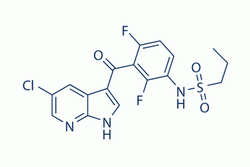| Cas No.: | 918505-84-7 |
| Chemical Name: | N-(3-(5-chloro-1H-pyrrolo[2,3-b]pyridine-3-carbonyl)-2,4-difluorophenyl)propane-1-sulfonamide |
| Synonyms: | PLX-4720,PLX 4720,PLX4720 |
| SMILES: | CCCS(=O)(=O)NC1=C(C(=C(C=C1)F)C(=O)C2=CNC3=NC=C(C=C23)Cl)F |
| Formula: | C17H14ClF2N3O3S |
| M.Wt: | 413.83 |
| Sotrage: | 2 years -20°C powder, 2 weeks 4°C in DMSO, 6 months -80°C in DMSO |
| Description: | PLX-4720 is a potent and selective inhibitor of B-RafV600E with IC50 of 13 nM in a cell-free assay, equally potent to c-Raf-1(Y340D and Y341D mutations), and 10-fold selectivity for B-RafV600E than wild-type B-Raf. |
| In Vivo: | Oral administration of PLX-4720 at 20 mg/kg/day induces significant tumor growth delays and regressions in B-RafV600E-dependent COLO205 tumor xenografts, without obvious adverse effects in mice even at dose of 1 g/kg. PLX-4720 at 100 mg/kg twice daily almost completely eliminates the 1205Lu xenografts bearing B-RafV600E, while has no activity against C8161 xenografts bearing wild-type B-Raf. The anti-tumor effects of PLX-4720 correlate with the blockade of MAPK pathway in those cells harboring the V600E mutation[1]. PLX-4720 treatment at 30 mg/kg/day significant inhibits the tumor growth of 8505c xenografts by >90%, and dramatically decreases distant lung metastases[3]. |
| In Vitro: | PLX-4720 displays >10 times selectivity against wild type B-Raf, and >100 times selectivity over other kinases such as Frk, Src, Fak, FGFR, and Aurora A with IC50 of 1.3-3.4 μM. PLX-4720 significantly inhibits the ERK phosphorylation in cell lines bearing B-RafV600E with IC50 of 14-46 nM, but not the cells with wild-type B-Raf. PLX-4720 significantly inhibits the growth of tumor cell lines bearing the B-RafV600E oncogene, such as COLO205, A375, WM2664, and COLO829 with GI50 of 0.31 μM, 0.50 μM, 1.5 μM, and 1.7 μM, respectively. In addition, PLX-4720 treatment at 1 μM induces cell cycle arrest and apoptosis exclusively in the B-RafV600E-positive 1205Lu cells, but not in the B-Raf wild-type C8161 cells[1]. PLX-4720 treatment (10 μM) significantly induces > 14-fold expression of BIM in the PTEN+ cells, compared with the PTEN- cell lines (4-fold), giving an explanation of the resistance of PTEN- cells to PLX-4720-induced apoptosis[2]. |






















